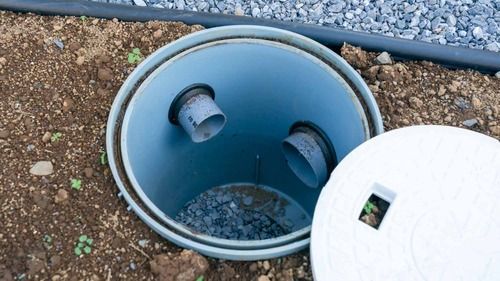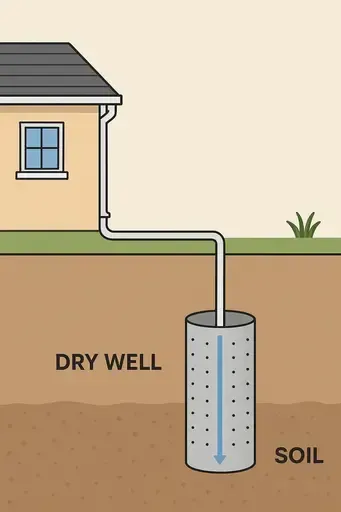Our Dry Well Installation Process
We focus on a detailed and efficient approach to installing dry wells that ensures proper drainage and water management around your property. Our process covers thorough site analysis, choosing durable materials, and a professional installation that meets local standards.
Site Evaluation and Planning
We start by assessing your property’s drainage patterns and soil type to determine the best placement for the dry well. This includes identifying where water pools or causes damage and measuring how much runoff the system must handle.
Understanding the soil’s permeability is crucial because it affects how quickly water will absorb. We also check for underground utilities to avoid conflicts during installation. Our experience helps us design a dry well system tailored specifically to your property’s needs, ensuring it functions efficiently over time.
Material Selection
Selecting the right materials is essential for long-term durability and performance. We use heavy-duty, corrosion-resistant components like high-density polyethylene or durable plastic for the dry well chambers.
Gravel and geotextile fabric surround the dry well to promote drainage and prevent soil from clogging the system. PVC piping connects the gutter downspouts to the dry well, ensuring smooth water flow. Our materials meet or exceed industry standards for stormwater management and are proven to withstand local weather and soil conditions.
Professional Installation Steps
Our team begins by excavating the area according to the planned dry well size and depth, reaching below the frost line when necessary. We install a layer of gravel at the base to facilitate drainage before placing the dry well chamber.
Next, we connect the downspout pipes securely to the chamber, making sure all joints are sealed and properly aligned to avoid leaks. Surrounding the dry well with gravel and covering it with geotextile fabric prevents soil infiltration. Finally, we backfill the excavation site, compacting soil carefully to avoid settling while maintaining proper water flow into the system.
This approach minimizes disruption to your property and ensures the dry well performs reliably.
Custom Drainage Solutions
We create drainage systems tailored to your property’s unique needs. Our approach considers existing structures and soil properties to ensure effective water management that prevents damage and maintains your landscape.
Integrating with Existing Gutter Systems
We connect dry wells directly to your current gutter and downspout setup. This seamless integration ensures water is efficiently redirected underground without disrupting your home’s exterior.
Our team uses durable pipes and fitting options designed to prevent clogs and withstand harsh weather. We offer choices like pop-up drains or dry wells, each selected based on your property’s layout and water flow patterns.
By assessing your existing gutters, we tailor the drainage path to maximize performance and extend system longevity.
Designing for Landscape and Soil Conditions
We assess soil type and landscape slope to position dry wells where they optimize water infiltration. Sandy, loamy, or clay soils each require specific designs for effective drainage.
Our designs avoid areas prone to waterlogging while ensuring runoff reaches the dry well efficiently. We consider slope gradients and soil permeability when selecting dry well size and placement.
This careful planning prevents erosion, standing water, and damage to plants and hardscapes. Our experience allows us to adapt solutions to different terrain conditions for reliable, long-term results.
Maintenance and Longevity
Proper maintenance is essential to keep your dry well functioning efficiently and to extend its lifespan. Regular care prevents blockages, erosion, and costly repairs, ensuring your drainage system protects your property effectively.
Routine Inspections
We recommend inspecting your dry well at least twice a year, especially after heavy storms. Look for signs like pooling water near the dry well or soggy areas in your yard, which may indicate poor absorption.
Check connections between downspouts and underground piping for damage or leaks. Inspect the surrounding soil for erosion or settling, which can affect drainage performance and structural stability.
Keeping a log of inspection dates and observations helps us track performance issues early. Prompt detection can save you from expensive repairs and maintain smooth water flow.
Cleaning Recommendations
Cleaning gutters and downspouts regularly is crucial since debris buildup directly affects dry well function. We suggest clearing leaves, dirt, and other materials at least twice a year, ideally in spring and fall.
If your downspout extensions or underground pipes are clogged, flushing them with water or using a plumbing snake can help restore flow. In some cases, professional cleaning may be necessary to remove sediment or debris inside the well.
We also recommend removing sediment buildup inside the dry well periodically. This typically involves vacuuming or excavating small amounts of debris to preserve soil absorption capacity.
Signs a Dry Well Needs Attention
Certain indicators suggest your dry well requires maintenance or repair. Look for standing water around the well that doesn’t drain within 24 hours after rain. Persistent flooding or soggy ground is a warning sign.
Other issues include unpleasant odors near the dry well or visible cracks in pipes or the stone-filled pit. These conditions suggest blockages or structural damage that compromise drainage.
If water backs up into gutters or the area around the foundation remains wet, contact us promptly. Addressing these problems early helps avoid more serious drainage failure and property damage.


